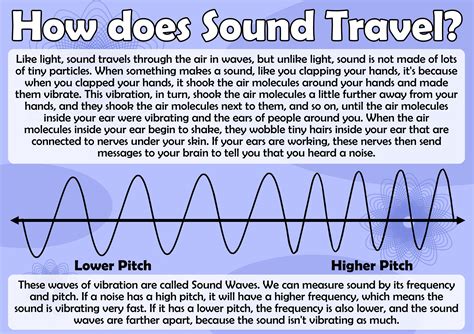5 Ways Sound Travels

Introduction to Sound Travel
Sound is a form of energy that is produced by vibrations. When an object vibrates, it creates a disturbance in the air particles around it, causing them to oscillate back and forth. This oscillation, or wave, is what we perceive as sound. The way sound travels is fascinating and can be understood through various mediums and methods. In this article, we will explore the five ways sound travels, highlighting the key principles and real-world applications of each method.
1. Through the Air: Sound Waves in Gas
The most common way sound travels is through the air, which is a gas. When a sound is produced, it creates pressure waves that propagate through the air molecules, causing them to compress and expand. This compression and expansion create a series of pressure waves that our ears detect as sound. The speed of sound in air is approximately 343 meters per second at room temperature and atmospheric pressure. Factors such as temperature, humidity, and air pressure can affect the speed of sound in air.
2. Through Solids: Sound Waves in Materials
Sound can also travel through solids, such as metals, woods, and concretes. When a sound is produced, it creates vibrations that travel through the solid material, causing the particles to oscillate. The speed of sound in solids is generally faster than in air, with some materials like steel and aluminum allowing sound to travel at speeds of over 5,000 meters per second. This property is utilized in various applications, including seismic exploration and non-destructive testing.
3. Through Liquids: Sound Waves in Water
Sound can travel through liquids, such as water and oil. When a sound is produced, it creates pressure waves that propagate through the liquid molecules, causing them to compress and expand. The speed of sound in water is approximately 1,482 meters per second, which is much faster than in air. This property is used in applications such as sonar technology and underwater communication.
4. Through the Ground: Sound Waves in Soil
Sound can also travel through the ground, which is a complex medium composed of various materials such as soil, rock, and water. When a sound is produced, it creates vibrations that travel through the ground, causing the particles to oscillate. The speed of sound in the ground is generally slower than in air, with speeds ranging from 100 to 1,000 meters per second, depending on the type of material and its density. This property is used in applications such as seismic exploration and geophysical surveying.
5. Through Other Mediums: Sound Waves in Plasmas and Vacuums
Sound can also travel through other mediums, such as plasmas and vacuums. In a plasma, sound waves can propagate through the ionized gas, creating pressure waves that travel at speeds of up to 10,000 meters per second. In a vacuum, sound waves cannot propagate in the classical sense, as there are no particles to transfer the energy. However, quantum fluctuations can create virtual particles that allow sound waves to travel through the vacuum, albeit at very low speeds.
🔍 Note: Understanding the different ways sound travels is crucial for various applications, including acoustics, seismology, and communication.
In summary, sound can travel through various mediums, including air, solids, liquids, the ground, and other mediums like plasmas and vacuums. Each medium has its unique properties and characteristics that affect the speed and behavior of sound waves. By understanding these principles, we can harness the power of sound for various applications and technologies.
What is the fastest medium for sound travel?
+
The fastest medium for sound travel is generally considered to be steel, with speeds of up to 5,960 meters per second.
Can sound travel through a vacuum?
+
Classically, sound waves cannot propagate through a vacuum, as there are no particles to transfer the energy. However, quantum fluctuations can create virtual particles that allow sound waves to travel through the vacuum at very low speeds.
What are some real-world applications of sound travel?
+
Some real-world applications of sound travel include sonar technology, seismic exploration, non-destructive testing, and underwater communication.